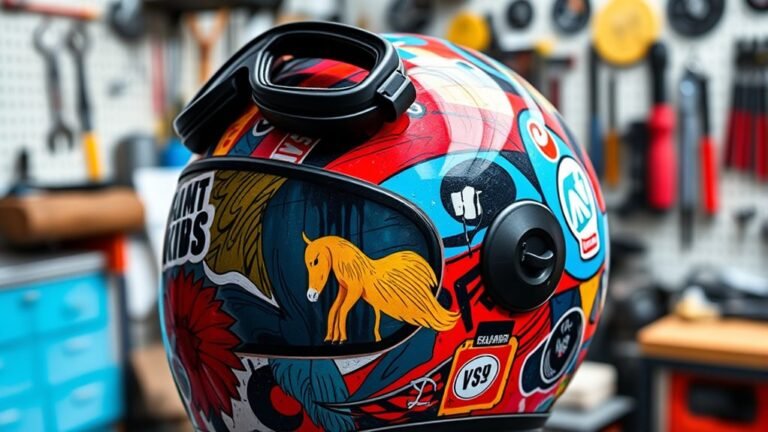Choosing an Environmentally Conscious Helmet
When choosing an environmentally conscious helmet, consider materials like recycled plastics and natural fibers that minimize your carbon footprint. Look for brands that prioritize eco-friendly manufacturing processes and hold safety certifications like CPSC or ASTM. This not only guarantees your protection but also aligns with your commitment to sustainability. Pay attention to the design and care for your helmet to extend its lifespan and reduce waste. There’s much more to explore about making a sustainable choice!
Understanding the Importance of Eco-Friendly Helmets

When you think about safety gear, it’s easy to overlook the environmental impact of your choices, but eco-friendly helmets are becoming increasingly important. These helmets not only protect your head during rides but also reduce the negative helmet impact on our planet. By opting for eco-friendly options, you’re making a statement about consumer awareness and your commitment to sustainability. Every time you choose a helmet made from recycled or sustainable materials, you’re contributing to a healthier environment, allowing you to enjoy your adventures without guilt. This freedom to ride while being environmentally conscious is empowering. So, as you gear up for your next journey, remember that your helmet choice can reflect your values and help create a better world for everyone.
Materials Matter: Recycled and Sustainable Options

Choosing the right materials for your helmet can make a significant difference in both safety and sustainability. By opting for helmets made from recycled plastics and natural fibers, you’re not just protecting yourself; you’re also making a choice that benefits the planet. Here’s a quick comparison to guide your decision:
| Material | Benefits | Environmental Impact |
|---|---|---|
| Recycled Plastics | Durable, lightweight | Reduces waste, lowers carbon footprint |
| Natural Fibers | Biodegradable, breathable | Supports sustainable agriculture |
| Foam Alternatives | Shock-absorbent | Often made from eco-friendly materials |
| Bio-based Resins | Flexible, strong | Less reliance on fossil fuels |
| Upcycled Materials | Unique designs | Diverts waste from landfills |
Choosing wisely empowers you to ride freely while caring for our Earth.
Eco-Friendly Manufacturing Processes

When you’re choosing an environmentally conscious helmet, the manufacturing process matters just as much as the materials. Look for brands that prioritize sustainable material selection, use energy-efficient production techniques, and implement waste reduction strategies. These eco-friendly practices not only reduce your carbon footprint but also support a healthier planet for future riders.
Sustainable Material Selection
As you consider the impact of your gear on the environment, it is essential to prioritize helmets made from sustainable materials and produced through eco-friendly manufacturing processes. Opting for helmets crafted from biodegradable options and renewable resources not only keeps you safe but also helps reduce your carbon footprint.
Here are some features to look for:
- Biodegradable foam for cushioning
- Recycled plastics for a lighter weight
- Organic cotton or hemp liner materials
- Plant-based adhesives
- Non-toxic paint finishes
Energy-Efficient Production Techniques
While it may seem like a minor detail, the production techniques used to create your helmet can considerably impact the environment. By choosing helmets made with energy-efficient technologies, you’re not just protecting your head but also supporting sustainable manufacturing practices. These processes reduce energy consumption and limit greenhouse gas emissions, helping to preserve the freedom of our planet for future generations. Look for brands that prioritize eco-friendly methods, like using renewable energy sources and minimizing resource waste during production. When you invest in a helmet crafted with these principles in mind, you’re making a statement about your commitment to the environment. So, gear up with a helmet that aligns with your values, and ride with confidence knowing you’re making a difference.
Waste Reduction Strategies
Choosing a helmet that employs waste reduction strategies not only benefits the environment but also enhances the overall quality of your gear. By opting for helmets made with eco-friendly manufacturing processes, you contribute to a greener future. Here are some key features to look for:
- Use of recycled materials in production
- Minimal packaging to reduce waste
- Manufacturing techniques that limit excess materials
- Support for recycling initiatives post-use
- Partnerships with organizations focused on environmental sustainability
Certifications and Safety Standards
When you’re selecting a helmet, understanding the various certifications and safety standards is crucial for your protection. Helmets that meet recognized safety certifications, like CPSC, ASTM, or Snell, have undergone rigorous testing to guarantee they can withstand impacts and protect your head effectively. These helmet standards are designed to keep you safe while you enjoy the freedom of riding, whether it’s on a bike, skateboard, or motorcycle. Don’t compromise on safety—check for these certifications before making a purchase. An environmentally conscious helmet that meets high safety standards not only contributes to your well-being but also supports sustainable practices. So, gear up with confidence, knowing that your helmet is both safe and eco-friendly, allowing you to ride freely and responsibly.
The Role of Design in Sustainability
Design plays a pivotal role in promoting sustainability, as it influences not only the aesthetics but also the materials and manufacturing processes of helmets. By embracing design innovation, you can choose helmets that are both stylish and environmentally friendly.
Consider these factors when evaluating a helmet’s design:
- Use of recycled or biodegradable materials
- Minimalistic design that reduces waste
- Modular components for easy repairs
- Aesthetic sustainability that aligns with your values
- Ethical manufacturing practices
When you prioritize these elements, you’re not just making a choice for yourself; you’re contributing to a broader movement toward sustainability. Each helmet reflects your commitment to both safety and the planet, allowing you to ride freely while protecting the environment.
Brand Commitments to Environmental Responsibility
When you’re choosing a helmet, it’s important to contemplate how brands commit to environmental responsibility. Look for companies that prioritize sustainable material sourcing, eco-friendly production processes, and recycling or end-of-life options. By supporting these brands, you’re not just protecting yourself, but also making a positive impact on the planet.
Sustainable Material Sourcing
As you consider purchasing an environmentally conscious helmet, it’s essential to pay attention to how brands source their materials. Opting for helmets made by companies committed to sustainable suppliers and material innovation not only protects your head but also the planet. Here are some key factors to look for:
- Use of recycled materials
- Biodegradable components
- Partnerships with ethical suppliers
- Transparency in sourcing practices
- Commitment to reducing carbon footprints
Eco-Friendly Production Processes
While many helmets focus on materials, the production processes behind them greatly impact their environmental footprint. You’ll want to look for brands committed to eco-friendly practices. A key element is the use of renewable energy during manufacturing, which can considerably reduce carbon emissions. Additionally, some brands utilize biodegradable coatings that minimize waste and lessen their ecological impact. By supporting these companies, you’re not just choosing a helmet; you’re embracing a lifestyle that values sustainability and responsibility. These choices empower you to enjoy your adventures knowing you’re making a positive difference. So, when selecting your next helmet, consider how its production aligns with your values and the environment. Freedom means making informed decisions that contribute to a healthier planet.
Recycling and End-of-Life Options
Choosing a helmet isn’t just about safety and style; it’s also about what happens to it at the end of its life. You want to choose brands that prioritize environmental responsibility, especially when it comes to recycling programs and disposal guidelines.
Consider these points:
- Many brands now offer take-back programs for old helmets.
- Look for helmets made from recyclable materials.
- Some companies partner with organizations to guarantee proper recycling.
- Always check the manufacturer’s disposal guidelines.
- Your choice can support a circular economy and reduce waste.
Caring for Your Helmet to Extend Its Lifespan
To guarantee your helmet lasts as long as possible, proper care is essential. Start by investing in good helmet storage—keep it in a cool, dry place away from direct sunlight. This prevents material degradation and maintains its structural integrity. When it comes to cleaning methods, avoid harsh chemicals; instead, use mild soap and water to remove dirt and sweat. A soft cloth works wonders for gentle cleaning. Regularly check for any signs of wear or damage, and replace your helmet if you notice significant issues. These simple steps not only extend your helmet’s lifespan but also enhance your freedom to ride with confidence, knowing you’re protected. Care for your helmet, and it’ll care for you in return!
Frequently Asked Questions
Are Eco-Friendly Helmets More Expensive Than Traditional Helmets?
Eco-friendly helmets can be pricier than traditional ones, but don’t let that deter you. When you consider the material differences, like sustainable composites versus standard plastics, the cost comparison becomes clearer. Investing in an eco-friendly helmet not only supports the planet but often offers better safety features. By choosing wisely, you’re not just protecting your head; you’re also contributing to a healthier environment, which aligns with your desire for freedom and responsible living.
How Can I Recycle My Old Helmet?
You can recycle your old helmet by checking local helmet recycling programs or facilities that accept sustainable materials. Some brands even offer take-back programs, allowing you to return your helmet for proper recycling. Avoid throwing it in the trash, as it contributes to waste. By recycling, you’re not only freeing up space at home but also supporting a circular economy. Every little action counts in creating a more sustainable future!
Do Eco-Friendly Helmets Offer the Same Safety Ratings?
Yes, eco-friendly helmets can offer the same safety ratings as traditional options. They’re designed to meet rigorous safety standards, ensuring your protection on the road. The material composition often includes sustainable resources that still provide excellent impact resistance. By choosing an eco-friendly helmet, you’re not only prioritizing your safety but also making a positive environmental impact. So, you can ride freely, knowing you’re covered while supporting a greener future!
Can I Find Eco-Friendly Helmets for Children?
Yes, you can definitely find eco-friendly helmets for children! Many brands now use sustainable materials that don’t compromise on safety. These helmets not only protect your child but also support a healthier planet. When you choose these options, you’re ensuring your child’s safety while promoting environmental responsibility. It’s a win-win! So, go ahead and explore the market for helmets that are both safe and sustainable for your little ones.
What Brands Are Leading in Eco-Friendly Helmet Production?
When you seek a helmet that symbolizes freedom while caring for the planet, look to brands like Nutcase and KED. They’re leading the charge with sustainable materials and impressive helmet certifications, ensuring you’re making a responsible choice. These brands blend safety and style, proving that eco-friendly doesn’t have to compromise on quality. By choosing them, you’re not just protecting your head; you’re embracing a greener future for all.






